Have you ever cultivated a garden for yourself? Did you do it thinking about being self-reliant, thinking it will be a dependable source of food for years to come with just a little daily effort to manage it? Did you plant it in neat little rows that you dug inside a carefully measured plot of land protected by chicken fence to keep out pests?
Did you spray a pesticide on your plants to protect them in their newly fertilized soil after a trip to the local store?
Look no further than other cultures and peoples who have lived without modern conveniences and modify your vegetable garden into a self-sustaining garden that not only survives on its own, but can do so in the aftermath of a long-term disaster: a survival garden.
Table of Contents
Why Use Ground Cover?
Planting ground covers you can eat just adds one more item to the long list of benefits of having a living green mulch instead of using straw or wood chips between plants.
This synergistic system of gardening may be a little untidier than the traditional rows of vegetables, but it has so many benefits. Just look what ground overs can do:
- ✅ Boost soil fertility by allowing for microbial activity.
- ✅ Conserve moisture by keeping the ground covered and cool.
- ✅ Some repel pests, while other provide food for beneficial insects like bees.
- ✅ A living mulch is less costly than having to buy wood chips or straw.
- ✅ Utilize the spare space in a vegetable garden.
- ✅ Ground covers can also be planted in food forests to add to the yield, providing they are planted according to their light requirements.
- ✅ For very little effort you get a welcome return in terms of vegetables, fruit and herbs from your groundcovers. You will need to select according to the space you have available, as some may be suited to balconies while others need larger spaces to sprawl out and cover the ground.
- ✅ Weeds are kept to a minimum as the ground covers don’t give them a chance.
- ✅ Less fertilizer needed as the sun doesn’t get a chance to leach nutrients from the soil.
A good ground covering plant is chosen for its suitability to the conditions of the area, its low maintenance and its ability to coexist with the other plants in your survival garden. Most ground covering plants can be in one of two categories, a clumper or a carpeter.
- Clumpers spread out leaves as they grow, making clumps of shade in varying heights. The roots are underground or at the point of the base of the plant.
- A carpeter does not need division and it quickly covers surfaces at one height, making an even blanket of ground cover.
The best way to fill out space and harvest edibles is to use herbaceous ground covering plants.
20 Edible Ground Covers to Grow
The following is a list of the best low maintenance ground cover plants for consideration your garden.
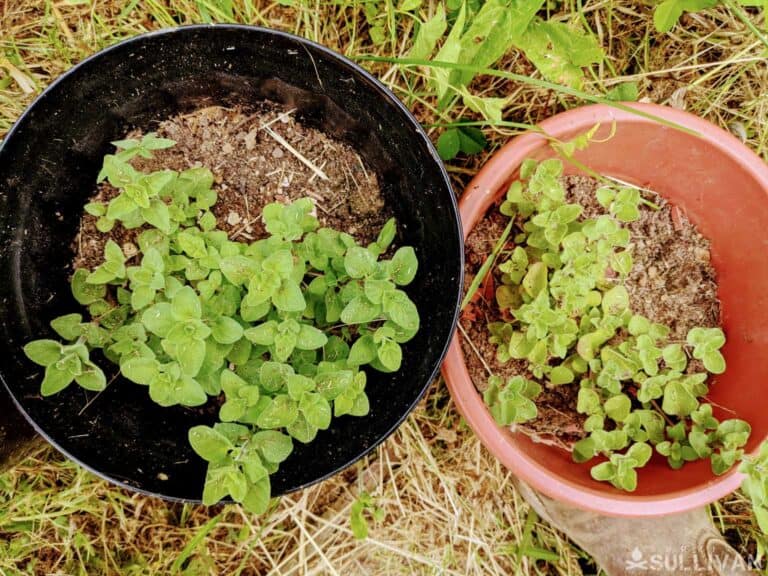
Oregano (Origanum vulgare)
- Height: 2 to 4 inches
- Spread: It keeps sending out suckers and will cover the areas between plants.
Oregano, is a hardy ground-covering edible with natural oils that repel some insects – so plant it near the edge of paths where it may get a little trampled to release those oils.
It is fairly drought tolerant; making it a good choice for those in dry climates. plant this bee-attracting ground-cover in full sun. It can tolerate partial shade too.
Oregano is a clumping type of ground covering, providing good cover and protection for your vegetable garden. In the east, oregano’s medicinal value has long been appreciated.
One use that modern researchers have applied to livestock, especially cows is its ability to reduce gas, specifically methane by up to 40% while it also increased milk production in grass-fed cows, according to a report and story by Livescience.
Oregano has been mentioned in most folk medicines and goes back as far as the times of Hippocrates. Ancient texts refer to oregano oil as crucial in the cooking and preservation of food. And what would modern day pizza be without oregano?
Oregano is used in:
- Numbing topical medicines
- Canning many sauces
- Meat products
- Perfumes
- Antifungal applications
- Antiseptic
- Soaps
- Detergents
- and more
There are various types of oregano including:
- Hot and spicy
- Golden
- Greek
- Mexican
- Cuban
Sage (Salvia officinalis)
- Height: 8 and 12 inches each plant spreads to.
- Spread: 12 to 18 inches
- Hardiness: drought tolerant, frost resistant down to around 15 degrees F (-9 Celsius).
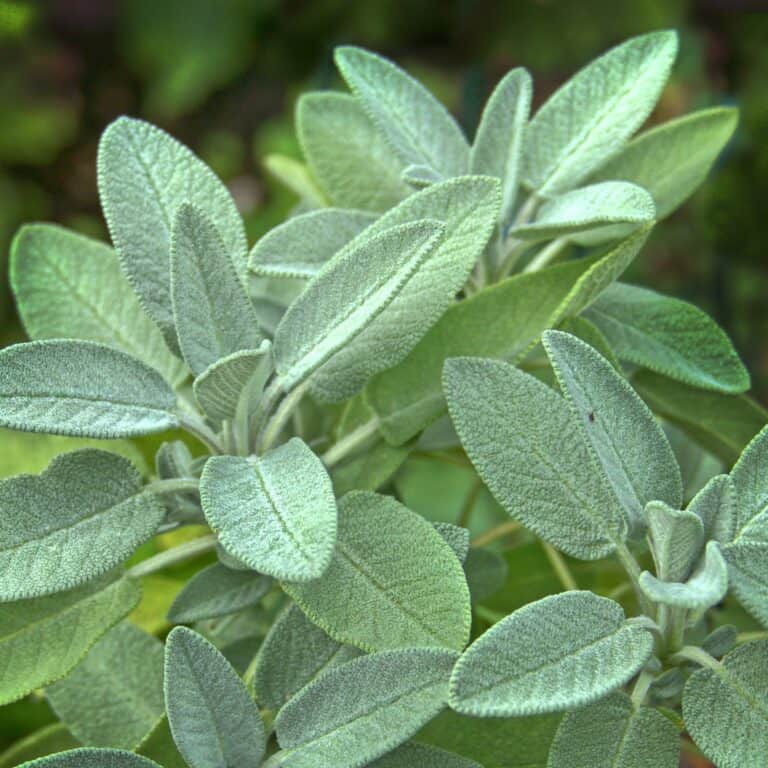
A good choice for cool and even warmer climates, sage goes well with meat and marinades, and can be included in pies and in breads.
The plant sends out shoots horizontally, keeping the soil moist. In hot climates it can do with some shade from the midday sun, but in cooler climates can grow in full sun.
The fine hairs on the leaves are a sign that it is water efficient. Despite frosts it will usually shoot up in the spring again. If you need some for dishes in the winter then pot up a couple of plants and keep them indoors.
Creeping Rosemary
- Height: 12 to 18 inches
- Spread: spreads to between 4 and 8 feet
- Hardiness: Hardy in USDA zones 8 to 10 but can be grown indoors over winter.
This variety of rosemary is similar in taste to the upright growing culinary herb, and is quite popular as an edible ground covering plant. It is very prominent in arid regions for providing shade for the soil while coexisting with many varieties of vegetables, as it is a drought tolerant evergreen plant .
It can be propagated through taking individual cuttings and rooting them or using established adults for divisional piecing. It has a very fibrous rooting system so it’s locks soil in place and prevents it being washed away, particularly on slopes.
The plant’s make up is 20% camphor so it can be used as a culinary herb or for medicinal uses.
Uses in history have included:
- Herbal tea
- Antiseptic
- Astringent
- Against inflammatory disorders
- Perfumes
- Improving the shelf life of oils and foods
Types for ground cover:
- Prostrates
- Irene
- Pyramidalis
- Albus
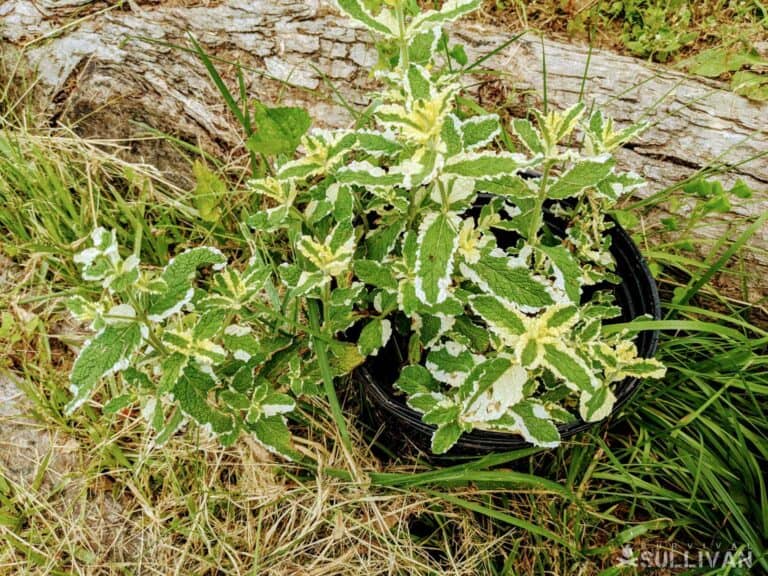
Mint
- Height: 4 to 6 inches
- Spread: rapidly spreads, sending out runners
- Hardiness: Can benefit from some shade but will survive in full sun. Dies down in winter unless kept indoors in cold climates.
If you have a moist place that needs filling, you may want to consider one of the varieties of mint. For shady areas, this edible quick growing ground cover is easy to acquire and grow. It does send our runners and can quickly become invasive but if planted with taller growing vegetables it is not a problem.
Be sure to have it in a place where you don’t mind it taking over between plants. Mint varieties can cross pollinate, so to retain the unique flavor and characteristics of each strain, do not plant them too close together. The many flavor profiles can enhance any soups, drinks, salads or teas.
There are hundreds of types. Some of the popular varieties are:
- Spearmint
- Peppermint
- Pineapple mint
- Chocolate mint
- Brazilian mint
- Mint sage
- Apple mint
- Orange mint
- Ginger mint
Uses in history have included:
- Medicine
- Herbal tea
- Essential oil extracts
- Antiseptic
- Astringent
- Treatment of inflammatory disorders
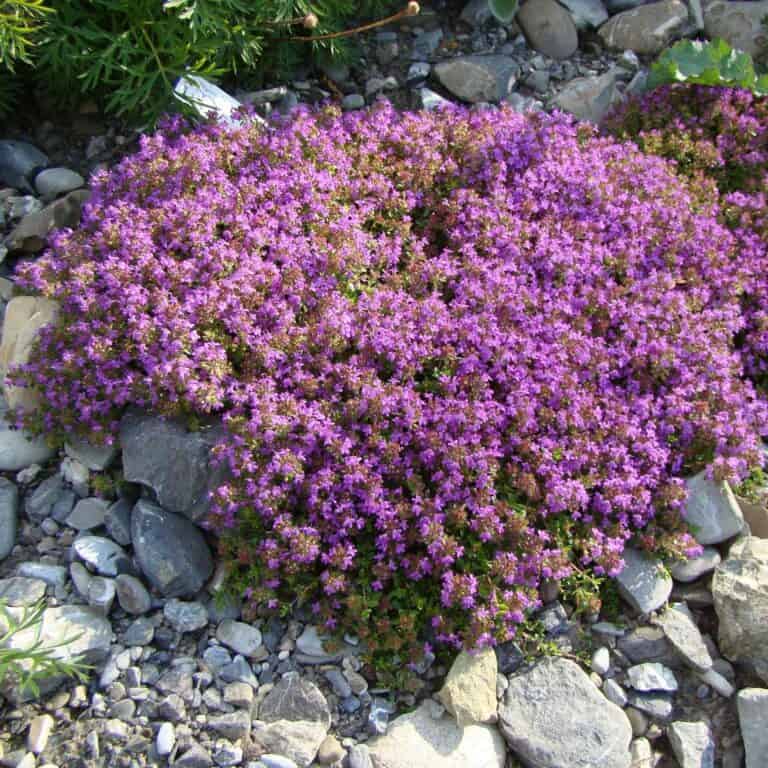
Creeping Thyme (Thymus serpyllum)
- Height: 2 to 3 inches
- Spread: Up to around 1 ½ feet.
- Hardiness: Can benefit from some shade but will survive in full sun. Dies down in winter unless kept indoors in cold climates.
If you have paths or need a plant that can stand up to foot traffic and isn’t fragile at all, try creeping thyme.
Thyme is usually seen along garden paths or as edging in survival or urban gardens for this very reason, it holds up and helps protect young plants and helps hold the soil, prevents it being washed out in heavy rains.
Common thyme has an upright growth pattern, but the creeping variety originating from Europe and North Africa are more carpet-like in growth.
Simple cuttings or division of adult plants can be used for this flourishing edible ground cover.
Uses include:
- Culinary seasoning
- Ornamental
- Aromatics
- Medicinal
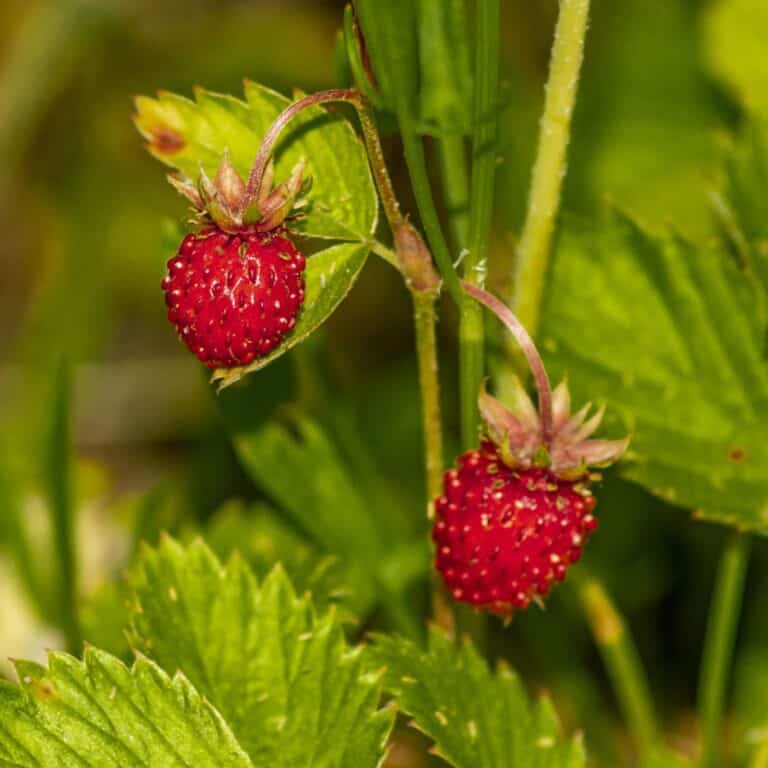
Woodland Strawberries (Fragaria virginiana)
- Height: 3 -6 inches
- Spread: 1 foot – sending out runners
- Hardiness: Perennial – will die off in frost but reappear in the spring
Recorded as being consumed since the Stone Age, wild or woodland strawberries can make a great fruit-bearing ground cover. They have a long flowering period and can form fruit on runners or in clusters known as crowns. They can be grown from seed or propagated via plant division and the fruit may be white or red..
Woodland strawberries are abundant producers of fragrant, strong tasting fruit and can grow in shady, moist spots that may be too wet for most garden seedlings.
They are used in:
- Jams
- Sauces
Alpine strawberries (Fragaria vesca)
- Height: 3 – 5 inches
- Spread: 1 foot
- Hardiness: Perennial – dies back in winter but will reappear the next season.
Alpine strawberries don’t propagate via runners like the common strawberry, making them perfect for intercropping if you want a little more control.
The fruit is tiny but very sweet and to get a cupful of strawberries for dessert you would need a few plants, but they provide all the benefits of a living mulch and the fruit – it’s a winner.
Add to this the fact that they are non-invasive, and can cope with a variety of soil conditions. They have a low growth habit and tend to hold fruits up high, often above the leaves.
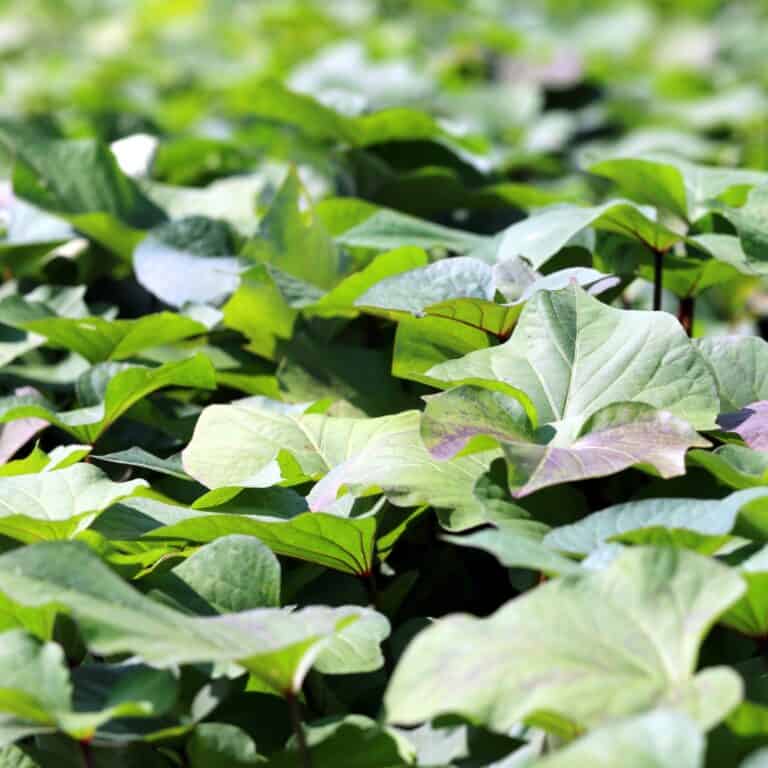
Sweet potato (Ipomoea batatas)
- Height: 6 to 8 inches
- Spread: 10 to 50 feet
- Hardiness: drought tolerant to a certain extent but need good water in the early growing period.
If you have the space plant sweet potatoes as they will spread beautifully covering the soil and provide you with a really worthwhile crop before winter sets in. New plants can be grown from the runners after you have dug up your harvest of sweet potatoes.
They prefer warm climates and will grow in zones 9 to 13 as a perennial and even in a protected spot in zones 7 and 8 if you have the right micro climate for them. If not, and in colder zones ,then treat them as an annual crop. There are various varieties – choose between white flesh , yellow and orange.
Nasturtiums (Tropaeolum Majus L.)
Nasturtiums spring to mind as an attractive flower, but the seeds, flowers and leaves can all be eaten. Create capers from the seeds, serve flowers whole in salads or chop flowers and leaves to mix into nasturtium butter – delicious on top of a piece of grilled fish or steak.
While nasturtiums can climb if they have a framework, they will work perfectly as a ground cover and are fairly hardy.
- Height: 8 – 12 inches
- Spread: around 3 feet to 6 feet unless you buy a dwarf variety
- Hardiness: grow in sun or semi- shade and will tolerate some dry soil, but prefer a moist soil. Plant after danger of frost is past
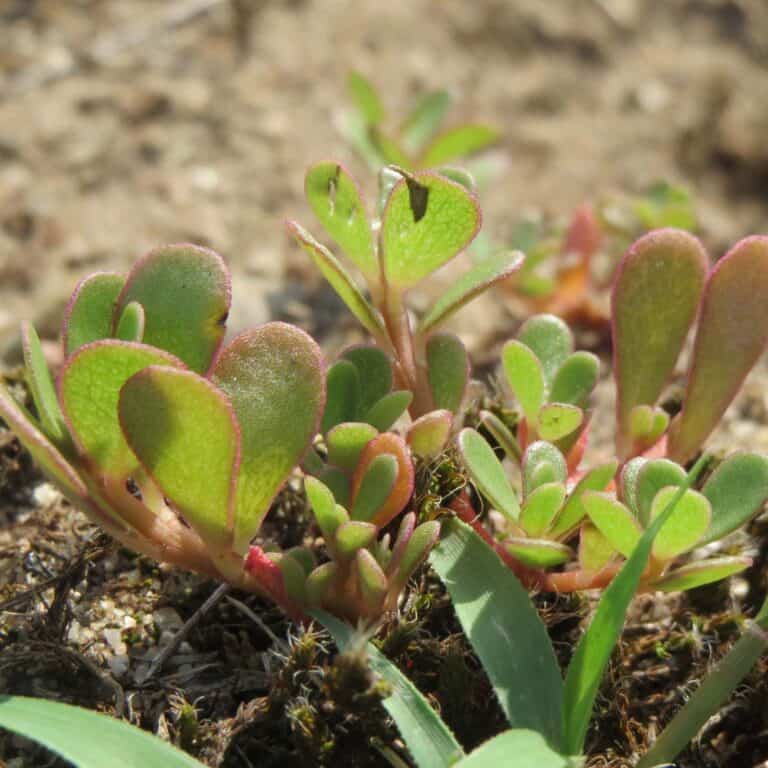
Purslane (Portulaca oleracea)
- Height: Maximum of 12 inches in shady areas. The drier and sunnier the climate the closer it grows to the ground.
- Spread: Spreads to form a thick mat keeping soil cool, and helps retain moisture.
- Hardiness: Drought hardy. Purslane will need water once getting established – after that water only in hot dry periods.
The Greek root of the name – oleracea means vegetable/herbal, which is quite apt as it has a number of uses both in salads, cooked food, and in teas. This plant that was native to Persia and India has spread all over the world.
Be careful not to confuse it with common spurge. The leaves of purslane are slightly fatter and more succulent-like. Spurge stems will exude a milky substance when cut and squeezed, which purslane does not.
Purslane will often be found growing in cracks but rather buy seed from a nursery instead of using plants from pavement areas where pesticide spray may have contaminated the plants. The plant has more omega 3 fatty acids than any other plant and is also rich in vitamins.
The flavour is a bit lemony and peppery with the freshness of cucumber. Many cultures chop it into salads. It is best eaten raw or very lightly cooked. Be careful when cooking as it can get slimy, somewhat like okra – so if cooking, cook it really well, past that slimy stage.
Pregnant women are warned not take purslane as it can cause contractions. It is apparently good for the digestive tract and people often drink a tea made from purslane leaves and stems infused for a few minutes.
Purslane is considered something of a miracle ingredient in cosmetics and ointments, being used in the treatment of burns, insect bites, eczema and skin sores. The cosmetic industry uses a great deal of purslane extract.
To propagate take cuttings 6 inches long, place in potting soil, give indirect sunlight and keep moist but not waterlogged. If sowing seed sprinkle on the soil and press down lightly – do not cover as purslane needs sunlight to germinate.
This annual will die when the first heavy frost comes. To keep it alive take it indoors and give direct sunlight. If this is not possible take cuttings and propagate for the next season. If it is outdoors the plant will have already self-sown and new plants will pop up when winter is over.
Pink Purslane (Portulaca pilosa)
Originating in Siberia and spread over North America and into South America, the plant is edible and a perennial, lasting two years or more. Like Portulaca oleracea it is hardy and will regrow after the winter.
French sorrel (Rumex scutatus)
- Height: maximum of 2 feet tall
- Spread: about one foot across
- Hardiness: Can tolerate temperatures down to – 20 degrees F.
True French sorrel should not be confused with the red veined or common sorrel. It is popular for its lemony flavor and its bright green leaves.
The mildest tasting leaves are the young ones grown in the cooler times of the year, otherwise they can be a bit acidic – something like rocket (aragula) which starts off mild but can have more of a bite as the leaves get older.
French sorrel is easily divided and can be planted in areas of bare soil where it will spread and shade the soil providing a green ground cover.
Winter melon (Benincasa hispida)
- Height: 12 inches
- Spread: 6 to 8 feet or more
- Hardiness: Plant seedlings or seeds once the temperature is above 60 degrees F. They are not frost tolerant, but are drought tolerant to an extent.
There are a surprising number of uses for winter melons which are part of the musk melon family. They can be included in soups, accompany stir fries, or be steamed and served as a vegetable. In Africa and India the melon is sliced very thinly and served over rice and curries.
In Japan it accompanies seafood with some soy sauce added, and in China the melon is used as the serving dish, once meat and vegetables have been cooked with the winter melon into a soup called dong kwa jong.
The flavor is mild, tasting a little like a zucchini, and the fruit of this Asian melon large, making it an ideal plant for use as a round cover. The flesh can be cubed and candied too.
Although sometimes allowed to climb, they make a good ground cover if you have plenty of space. Winter melons like a well-drained soil, will survive some dry periods, but cannot tolerate waterlogged soil.
They take a relatively long time to grow, but can be harvested anytime from a week after setting the fruit to eight weeks afterwards.
Also known as wax gourds, winter melons start off with a downy covering, then this is replaced on mature melons with a waxy outer skin. Watch out for mildew on plants and attacks from aphids.
Cucumbers (Cucumis sativus)
- Height: 6 to 8 inches
- Spread: 6 to 8 feet or more
- Hardiness: Plant seedlings or seeds once the temperature is above 60 degrees F. They are not frost tolerant, but are drought tolerant to an extent.
We tend to associate cucumbers with trellises, but they grow perfectly well on the ground, shading the soil. Depending on the type you choose to plant you can either use them for pickling or for adding to salads.
Although they are mostly water and not particularly nutritious they do contain plenty of Vitamin K – useful in blood clotting, and are well known for their anti-inflammatory properties.
Warrigal greens (Tetragonia tetragonioides)
- Height: 8 inches
- Spread: 6 feet or more
- Hardiness: They are not frost tolerant, but are drought tolerant to an extent. In colder zones treat as a n annual. In sub-tropical zones they may die back a bit in winter but will regrow in the spring as long as they are in a frost free area.
Known as New Zealand spinach, early sailors harvested the greens and used them as a spinach replacement. Warrigal green were also used by the native inhabitants of Australia and New Zealand. The bright green leaves, like common spinach, are rich in oxalates, so blanch or cook to break these down.
When leaves are eaten raw the oxalates can bind to calcium, preventing absorption of other nutrients beneficial to the body. They tend to attract lizards, who are welcome as they eat the insects which would otherwise devour your other plants.
Warrigal greens grow in full sun to part shade and besides being used as a ground cover can be planted in pots too. Add to soups, stews, or stir fry with some garlic for a delicious vegetable dish. They can also be served as creamed spinach.
Pumpkins (Cucurbita)
- Height: This will vary depending on the variety but around 6 to 12 inches
- Spread: Pumpkins runners can be really long – 8 to 12 feet or more.
- Hardiness: Zones 3 to 9. They will grow in warmer climates but you have to watch out for pests and mildew in wet weather.
Pumpkins make a perfect ground cover, providing tasty fruit. There are so many varieties, but for a stealth survival garden go for the smaller varieties that would not be too obvious to the casual observer.
Baby Boo, Jack B Little, Hooligan, Bumpkin and Wee B Little are just a couple of the varieties with small pumpkins. Pick from varieties that are white with yellowish stripes, little orange ones, knobbly or smooth.
They need full sun, a rich soil and plenty of space to spread out. In cooler zones start them indoors 2 to 4 before the last usual last frost date. Transplant outdoors just before they develop to the four leaf stage.
Patty Pans (Cucurbita Pepo)
- Height: Around 6 to 8 inches
- Spread: Up to 6 feet
- Hardiness: They do not tolerate frost. Treat as you would for pumpkins.
These delightful little squash with their scalloped edges and bright yellow color are in demand in top restaurants and fetch a high price in supermarkets.
Grow your own by planting seeds on a slightly raised mound around 2 to 3 feet from each other so they can spread and cover the ground. Unlike other pumpkin type vines they are not as inclined to climb, and are perfect for smaller gardens.
Zucchini (Cucurbita Pepo variety)
- Height – 6 to 8 inches
- Spread: 6 feet or more
- Hardiness: Treat as a summer crop in regions with hot dry summers. In tropical and subtropical areas grow as a cool weather crop. They can withstand some dry spells once established and enjoy a rich soil.
Zucchini with their marrow like appearance are small, growing not much more than 6 inches long. Pick them young and enjoy them steamed, chopped into stir fries or fried whole with garlic and butter.
The vine is sprawling and in the pumpkin family, so will tend to climb if it has a support. They are good to grow with sunflowers or maize which will give them support.
Mostly they will sprawl across the ground providing shade for the soil.
Wood sorrel (Oxalis acetosella)
Usually regarded as a perennial weed wood sorrel pops up in gardens, however it is edible – leaves, flowers and immature seed pods too.
Add them fresh to salads or use as seasoning in sauces. You can even make wood sorrel tea by steeping the leaves in hot water and drinking the tea sweetened with honey. It does contain oxalic acid so should not be eaten raw in large quantities.
Many other plants contain oxalic acid so this shouldn’t be a worry – onion and turmeric both contain oxalic acid. However plants containing oxalates can be fatal to animals – do not feed these to livestock or pets as they can die from renal failure if they consume a lot.
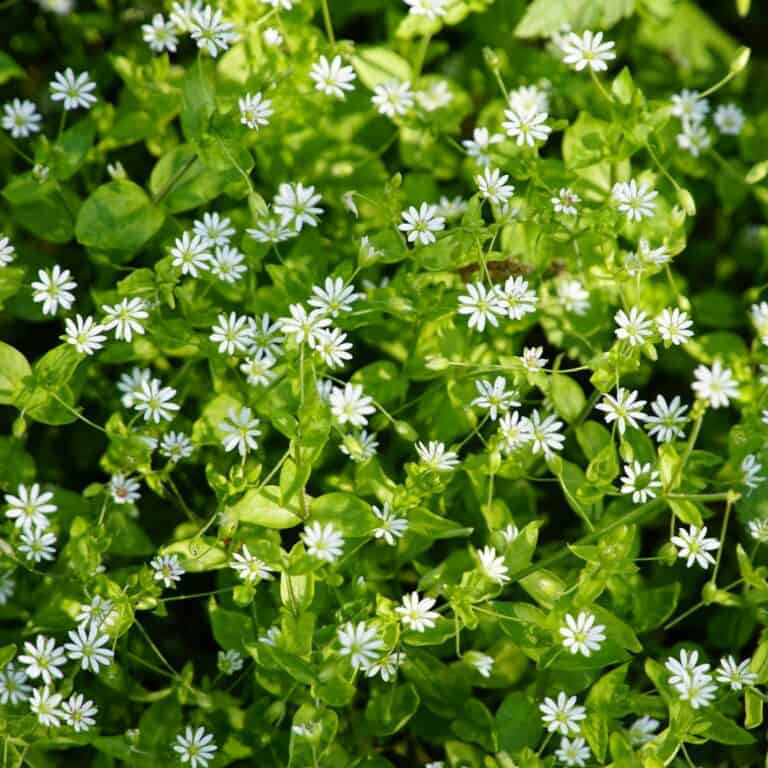
Chickweed (Stellaria media)
- Height: 2-3 inches
- Spread: around 1 foot – easily propagates and self-seeds to form a dense mat
- Hardiness: Will die off in winter to re-emerge in spring in colder climates, but in warm areas with no frost it will grow all year round.
This plant forms a pretty green mat across areas providing food for both humans and animals. It can be a nuisance once it gets into lawns but in a food forest can be very useful as a ground cover.
Fresh chickweed chopped and added to sandwiches is delicious. It can also be added to stir fries.
The levels of oxalic acid in chickweed is very low so not of concern. It can become something of a nuisance so consider planting with care. It will grow best in semi-shade. Chickens and birds love it, as do pet rabbits and guinea pigs.
Wintergreen (Gaultheria procumbens)
- Height: 6 inches
- Spread: around 1 to 2 feet – it will send creeping rhizomes along the ground, popping up new growth.
- Hardiness: Zones 3 to 7
This plant goes by the names of boxberry and eastern tea berry. The small red berries are made into jams or added to salads.
This slow growing plant enjoys dappled light under trees, making it a perfect understory plant. Propagate by dividing established plants, taking cuttings or planting seed. Although it is not a true mint it does have a minty flavor.
Which Cover Crops Have You Decided On?
In the future when there may be potentially no refrigeration or electricity, having survival gardens that produce fruit and edible foliage year round can make all the difference.
Saving those gardens from erosion and predation, while hiding them in plain sight may take some planning, but it is well worth the effort.
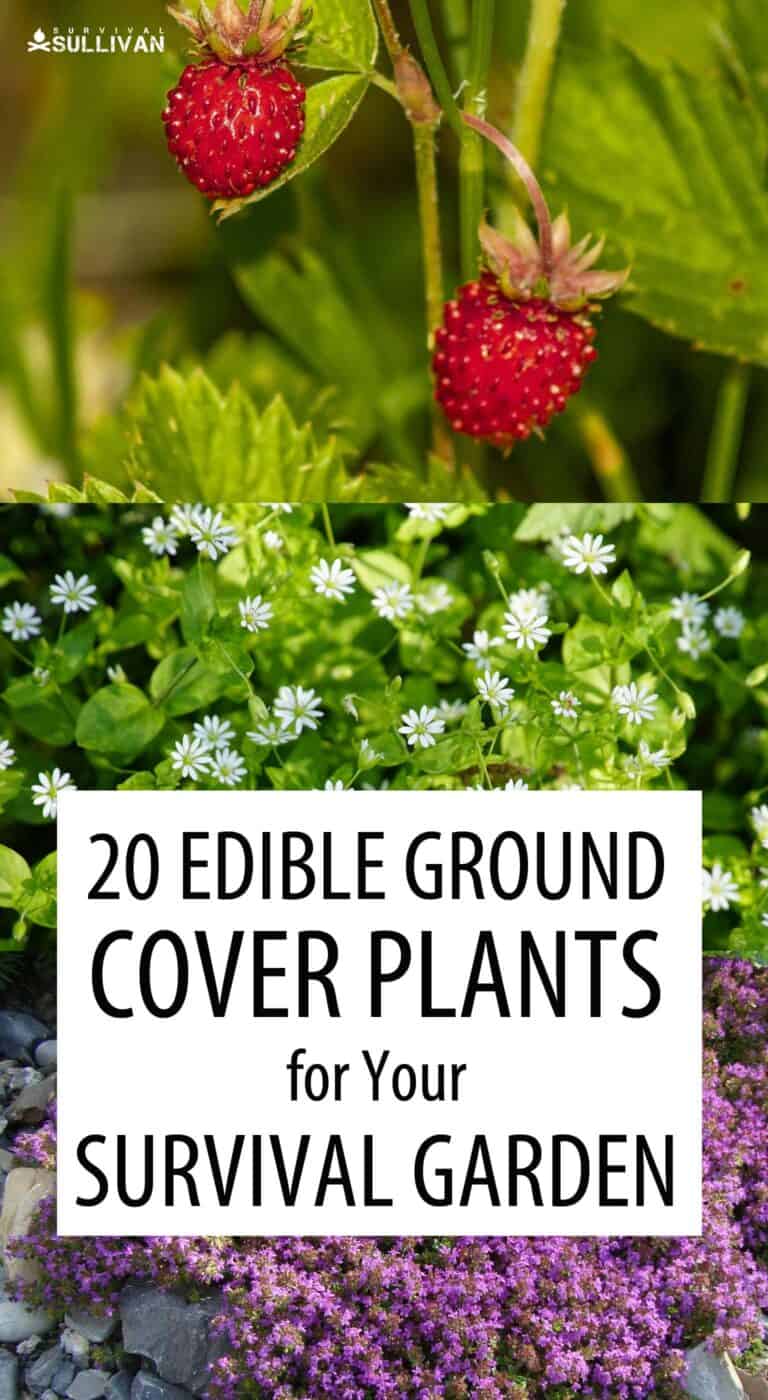
updated 02/16/2022 by Jeanie Beales

Growing up in the Bluegrass State, it was a point of familial pride to be able to shoot, trap, identify plants and track animals. Summer camps helped us be well versed in camping, weapons, and survival skills from a young age. We were surrounded by such a lush environment, and we used the resources we had.
I met my soulmate in my happiest place to be- a seemingly enchanted winding trail next to a beautiful wooded glen- where I spent as much time exploring as I could during daylight hours with my trusty four-legged friends.
The bucket list includes living the days painting and writing on a fully self-sufficient homestead, off-grid with our animals and family and plenty of land for the significant other (who I think is a true artist at weapons and living that way) to shoot to his heart’s content. Naturally organic living for us and the animals is a goal.

Great work and time in this article, food for thought. Hiding a garden from the hoards is good its great . But it is impossible to sustain life on herbs alone. So how do we disguise real veg that would sustain life. Root crops are easy to hide. But what about the like of cabage, cauli, beans, peas, tomatoes, sprouts ect. They need lotsa sunshine so to hide them they will not survive unless grown on the roof and than some gov drone will freak you out. Herbs are great as an additive to food but real food still has to be grown to sustain life.
Great start for hidden garden though. 10/10.
Thanks so much, we have some survival gardening articles, but I will take a look into this and see if we can address this as it will be important to be able to hide the goodies!
Thanks for reading!
Dyann